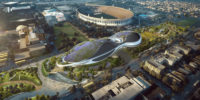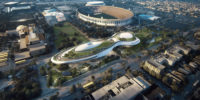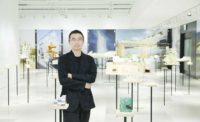Los Angeles, California
Your visit starts in an unremarkable city park adjacent to a generic shopping mall. Local kids are playing tag, while a man in short sleeves throws a stick for his dog and a family picnics on the grass. You follow a concrete path, which turns into a gently sloping ramp descending into the ground. On either side of you, concrete walls rise to meet an angled green roof, slowly blocking out the sounds of people enjoying the park. The laughter gets more faint, the excited chatter less distinct. As you enter the Los Angeles Museum of the Holocaust (LAMOTH), you get a hint of what Jews and other persecuted people must have experienced on their way to Nazi concentration camps, gradually losing contact with the small pleasures of the everyday world. The architectural procession, as designed by Hagy Belzberg, confronts you with what Hannah Arendt called “the banality of evil,” a phrase that chills us still because it conflates the quotidian with the horrific.
Tucked into the side of Pan Pacific Park, behind a parking lot servicing a post office and a shopping center called the Grove, LAMOTH is easy to miss. Instead of aiming for the heroic or monumental, Belzberg used a “layered strategy combining the urban and the metaphorical,” he explains. By “urban” he means a design that fits into its park location and works with the residential neighborhood just beyond. And by “metaphorical” he means a building that alludes to the Holocaust without being literal or specific. Because the museum deals with other genocides in addition
to the one perpetrated by the Nazis, Belzberg steered away from any Jewish iconography.
During his research for the job, Belzberg visited many of the 16 major Holocaust museums in the United States and related projects abroad. One that struck a responsive chord with him was Peter Eisenman’s Memorial to the Murdered Jews of Europe, which stands in the heart of Berlin and draws people who happen to be in the area as well as those intent on visiting the site. “Seeing and hearing people having their lunch or enjoying the outdoors actually added to the experience,” recalls the architect, because it reminds you that some people’s lives continued during the Holocaust while others’ came to a ghastly end.
He also appreciated that Eisenman’s design — 2,711 concrete blocks of varying heights — engages people and that its “symbolism is open” to interpretation.
Working with a small size (36,000 square feet) and a limited budget ($14 million, or $389 per square foot), Belzberg and his team created an intense experience by using a few simple devices — such as compressing space in certain areas, releasing it in others, and manipulating daylight everywhere. Soon after visitors move from the open park to the narrow entry ramp, they begin to feel the mood change. As they descend to the lobby, they find themselves enveloped by an exposed concrete skeleton that is both sensuous in its curves and a bit ominous in its form. To save money and time, the architects used shotcrete to create the fluid geometry of the vertical walls and poured concrete only for the roof and floors. (After spraying the shotcrete on steel reinforcing bars, workers troweled the walls to give them their curves and smooth finish.)
LAMOTH, which was founded in 1961 by Holocaust survivors and had a Wilshire Boulevard location for a number of years, still has more than 25 survivors working as docents. At the reception desk of the museum’s new home, each visitor gets an iPod, which provides sounds and images that help bring history to life. The first exhibition space, entitled “The World That Was,” features a large “community table” with a display that engages visitors as a group.
As people move through the museum and the topics become more grim (Kristallnacht, the Nazi concentration camps), the building’s sloping roof makes the rooms feel tighter and darker. At the same time, visitors experience the exhibits less as a group and increasingly as individuals engaging with a single screen or image. Daylight slips inside from above and around the edges of walls — a precious commodity brought in as if by stealth. One display looks at genocides in places such as Darfur and Rwanda. Underneath the entry ramp, artifacts from the Auschwitz-Birkenau State Museum in Poland stand as silent witnesses.
But even as the rooms get more constricted, the architects offer views to the other side of the circulation loop where exhibits tell about the liberation of the camps and survivors making new lives in Los Angeles. Near the exit, a presentation room gives visitors the chance to hear a survivor talk about the Holocaust. Then as they leave, they return to the park and the sounds of people going about their lives. Just outside the building, an existing sculpture dedicated to the Holocaust leads visitors to an outdoor room that Belzberg designed in memory of the 1.2 million children killed during the Nazi era. Wrapping the walls around the space, glass-fiber-reinforced concrete tiles punched with 1.2 million holes of different sizes and depths make a visual and tactile reference to the young lives lost six decades ago.
The building earned a LEED Gold Certification by insulating interior spaces with a 2-foot-thick green roof, capturing rainwater and using it for irrigation, and including recycled fly ash in the concrete, among other strategies.
In deferring so thoroughly to its park setting, the museum lost a chance to project a stronger public profile. But its refusal to preach and its dramatic procession of increasingly intense spaces engage visitors in an architectural and philosophical dialogue not easily forgotten or ignored.
PeopleOwner: The Los Angeles Museum of the Holocaust (building) / City of Los Angeles (land) Architect Personnel in architect's firm who should receive special credit: Architect of record: Hagy Belzberg FAIA Interior designer: Museum display design, content graphics, Belzberg Architects Engineer(s) Mechanical Engineer: John Dorius Electrical Engineer: Alex Antonio Plumbing Engineer: Tom Nasrollahi Soils/Geology: Jon Irvine Consultant(s) General contractor Photographer(s) |
ProductsStructural system Exterior cladding Precast concrete: FQC PreCast Solution Moisture barrier: Epro Waterproofing Systems, Inc. Roofing Elastomeric: Epro Waterproofing Systems, Inc. Windows Glazing Doors Wood doors: Timely Hardware Closers:Norton Exit devices:Corbin Russwin Pulls:Musco Interior finishes Demountable partitions: Spectrum Oak Products Cabinetwork and custom woodwork: Spectrum Oak Products Paneling: Spectrum Oak Products Carpet: Karastan Raised flooring: Furnishings Reception furniture: Spectrum Oak Products Chairs: Knoll Upholstery: Knoll Lighting Downlights: Janmar Exterior: Inovus Solar, Hunza Conveyance Plumbing Energy |
















Post a comment to this article
Report Abusive Comment